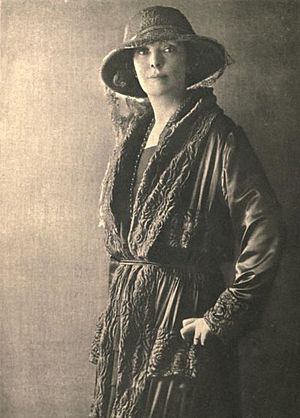Lady Angela Forbes facts for kids
Quick facts for kids
Lady Angela Forbes
|
|
|---|---|

Lady Angela Forbes, photographed by Dorothy Wilding, 1921
|
|
| Born | 11 June 1876 Mayfair, England
|
| Died | 22 October 1950 (aged 74) |
| Nationality | British |
| Occupation | Author |
| Known for | British socialite and novelist |
| Spouse(s) | James Stewart Forbes (1872–1957) |
| Children | 2 |
| Parent(s) | Robert St Clair-Erskine, 4th Earl of Rosslyn Blanche Adeliza FitzRoy |
Lady Angela Selina Bianca Forbes (born St Clair-Erskine; 11 June 1876 – 22 October 1950) was a British writer and well-known person in society. She became famous for organizing special canteens (places to eat) for soldiers in France during the First World War. People sometimes called her a "forces sweetheart" because of her work. In 1929, she started using her birth name again.
Contents
Lady Angela's Early Life and Education
Lady Angela Forbes was born on June 11, 1876, in Mayfair, England. She was the youngest daughter of Robert St Clair-Erskine, who was the 4th Earl of Rosslyn, and Blanche Adeliza FitzRoy. She had several sisters and brothers.
She grew up in Scotland and Lincolnshire, England. German teachers taught her at home. Lady Angela was quite tall, almost six feet. She was known for being lively and fun. She did not want to finish her education in Germany, so she continued her studies in Scotland instead.
Lady Angela enjoyed outdoor activities like fox-hunting and shooting. She was even shown riding a horse in a famous magazine called Vanity Fair.
Lady Angela's Career and Family Life
Marriage and Writing Career
On April 28, 1896, Lady Angela married James Stewart Forbes. He was an army officer. They had two daughters named Marigold (born 1897) and Flavia (born 1902).
Between 1910 and 1912, Lady Angela wrote and published four novels. She wrote these books mainly because she needed to earn money.
Helping Soldiers During World War I
When the First World War began, Lady Angela volunteered at a hospital in Paris. She helped by taking notes for the doctors. A few weeks later, she saw many injured soldiers arriving by train in Boulogne, France. She noticed they were left on the docks for hours without food or water.
In November 1914, she decided to help. She started a canteen for soldiers in a railway station waiting-room. This small canteen grew into a network of canteens. They were officially called the British Soldiers' Buffets, but many soldiers simply called them "Angelinas."
Lady Angela and her team of volunteers, often friends and family, met every train carrying wounded soldiers. They provided food and drinks. At first, money for supplies came from newspaper appeals. Later, in 1915, the canteens began to charge a small fee for food and drinks.
In 1916, Lady Angela opened more canteens in Étaples. This was a major camp for British soldiers in France. She opened one canteen for workers building the army camp, another for soldiers training there, and a third at the railway station for men going to the front lines. These canteens often stayed open all day and all night.
With the money earned from her canteens, Lady Angela built fourteen recreational huts for soldiers to relax in. However, some senior army officers found her difficult to work with. In September 1917, she was told to leave the Étaples base without a clear reason. She protested, but her efforts to stay were unsuccessful. Later, in February 1918, her work was discussed in the British Parliament. Government officials recognized her valuable work and praised her dedication.
Life After the War
After the war ended, Lady Angela tried a few new projects. She started a training program for soldiers who had been injured. She also opened a dress shop. In 1921, she published her first book of memories, called Memories and Base Details.
In 1929, she officially changed her name back to her birth name, St Clair-Erskine. She traveled a lot and wrote about her journeys in another book, Fore and Aft (1932).
Lady Angela Forbes passed away on October 22, 1950, on the island of Jersey. She was buried at Rosslyn Chapel in Scotland. In 2023, she was honored as one of the notable women connected to Lincolnshire, England.
Lady Angela's Descendants
Lady Angela Forbes and James Stewart Forbes had two daughters:
- Marigold Forbes (1897–1975) married Sir Archibald Sinclair in 1918. He later became a leader of the Liberal Party. In 1952, he was given the title Viscount Thurso. They had four children. Their grandson, John Thurso, is still a member of the British Parliament's House of Lords.
- Flavia Forbes (1902–1959) married Lionel Heald in 1923. She later married Colonel Lionel Herbert de Pinto in 1933. In 1939, she married Sir Alexander Hay Seton. Flavia had a daughter named Susan and a son named Michael.


